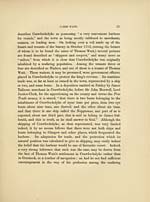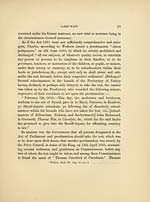Memorials of the lineage, early life, education and development of the genius of James Watt
(40) Page 22
Download files
Complete book:
Individual page:
Thumbnail gallery: Grid view | List view

22 MEMORIALS OF
people of the former town, there is little likelihood that he would
permanently have remained there.
The first notice obtained of this ancestor of Watt, in any public
document, is during the dark period of civil commotion and suffering
in Scotland, which intervened between the Restoration of Charles II.
and the Revolution. Few were permitted to be merely indifferent, or
to hold a neutral position in those infatuated times. Thomas Watt,
from the nature of his functions, became involved under one of the
propositions of the infamous " Test Act," and forthwith was publicly
denounced as a " disorderly schoolmaster, officiating contrary to law."
The delinquency was, of course, of a political, not of a moral character.
The occasion was as follows : — The Scots Parliament, in which the
Duke of York sat as commissioner for his brother Charles II., on 31st
August 1681, passed an Act titled " Act anent religion and the test,"
by which a certain oath was required to be taken and subscribed by
all persons " in public trust." As the statute was most arbitrary in
its enactments, and the oath or test no less so, the Earl of Argyll, on
the passage of the Act through Parliament, objected to some of its
clauses, and afterwards declined to take the oath without an explica-
tion. For this explication, which was construed into leasing-making
and high treason, the Earl was immediately afterwards indicted, tried,
and convicted, and sentence of death was pronounced against him on
23d December 1681. Having been committed prisoner to the Castle
of Edinburgh till the king's pleasure should be known, the Earl, having
good reason to apprehend, from the vindictive and bigoted temper of
the Duke, and his well-known influence over his brother, that the
sentence would be carried into execution, effected his escape from the
Castle, and fled to the Continent. On the accession of the Duke to
the crown in 1685, under the title of James VII., the Earl headed a
hostile invasion of Scotland, but his adherents having been dispersed,
he was made prisoner near Renfrew, conducted to Edinburgh, and
people of the former town, there is little likelihood that he would
permanently have remained there.
The first notice obtained of this ancestor of Watt, in any public
document, is during the dark period of civil commotion and suffering
in Scotland, which intervened between the Restoration of Charles II.
and the Revolution. Few were permitted to be merely indifferent, or
to hold a neutral position in those infatuated times. Thomas Watt,
from the nature of his functions, became involved under one of the
propositions of the infamous " Test Act," and forthwith was publicly
denounced as a " disorderly schoolmaster, officiating contrary to law."
The delinquency was, of course, of a political, not of a moral character.
The occasion was as follows : — The Scots Parliament, in which the
Duke of York sat as commissioner for his brother Charles II., on 31st
August 1681, passed an Act titled " Act anent religion and the test,"
by which a certain oath was required to be taken and subscribed by
all persons " in public trust." As the statute was most arbitrary in
its enactments, and the oath or test no less so, the Earl of Argyll, on
the passage of the Act through Parliament, objected to some of its
clauses, and afterwards declined to take the oath without an explica-
tion. For this explication, which was construed into leasing-making
and high treason, the Earl was immediately afterwards indicted, tried,
and convicted, and sentence of death was pronounced against him on
23d December 1681. Having been committed prisoner to the Castle
of Edinburgh till the king's pleasure should be known, the Earl, having
good reason to apprehend, from the vindictive and bigoted temper of
the Duke, and his well-known influence over his brother, that the
sentence would be carried into execution, effected his escape from the
Castle, and fled to the Continent. On the accession of the Duke to
the crown in 1685, under the title of James VII., the Earl headed a
hostile invasion of Scotland, but his adherents having been dispersed,
he was made prisoner near Renfrew, conducted to Edinburgh, and
Set display mode to:
![]() Universal Viewer |
Universal Viewer | ![]() Mirador |
Large image | Transcription
Mirador |
Large image | Transcription
Images and transcriptions on this page, including medium image downloads, may be used under the Creative Commons Attribution 4.0 International Licence unless otherwise stated. ![]()
| Histories of Scottish families > Memorials of the lineage, early life, education and development of the genius of James Watt > (40) Page 22 |
|---|
| Permanent URL | https://digital.nls.uk/95169934 |
|---|
| Description | A selection of almost 400 printed items relating to the history of Scottish families, mostly dating from the 19th and early 20th centuries. Includes memoirs, genealogies and clan histories, with a few produced by emigrant families. The earliest family history goes back to AD 916. |
|---|

